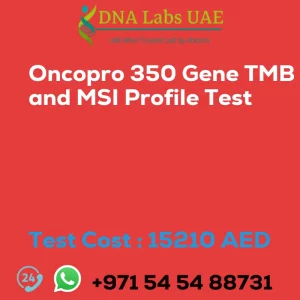IMMUNOHISTOCHEMISTRY NEUROFILAMENT POLYPEPTIDE Test
Test Name: IMMUNOHISTOCHEMISTRY NEUROFILAMENT POLYPEPTIDE Test
Components: Neurofilament polypeptide
Price: 410.0 AED
Sample Condition: Submit tumor tissue in 10% Formal-saline OR Formalin fixed paraffin embedded block. Ship at room temperature. Provide a copy of the Histopathology report, Site of biopsy and Clinical history.
Report Delivery: Sample Daily by 6 pm; Report Block: 5 days Tissue Biopsy: 5 days Tissue large complex: 7 days
Method: Immunohistochemistry
Test Type: Cancer
Doctor: Oncologist, Pathologist
Test Department: Pre Test Information
Pre Test Information: Provide a copy of the Histopathology report, Site of biopsy and Clinical history.
Test Details
Immunohistochemistry (IHC) is a technique used to detect specific proteins in tissue sections. Neurofilament polypeptides are a group of proteins found in the cytoskeleton of neurons and are involved in maintaining the structural integrity of neurons.
To perform an immunohistochemistry test for neurofilament polypeptides, the following steps are typically followed:
- Tissue preparation: Tissue samples, usually obtained from a biopsy or autopsy, are fixed in a suitable fixative, such as formalin, to preserve the tissue structure and proteins.
- Tissue sectioning: The fixed tissue is embedded in a paraffin wax block, and thin sections (usually around 4-6 micrometers thick) are cut using a microtome. These sections are then mounted onto glass slides.
- Antigen retrieval: Formalin fixation can mask the antigenic sites on proteins, making them inaccessible to antibodies. Antigen retrieval methods, such as heat-induced epitope retrieval (HIER) or enzymatic digestion, are used to unmask these sites and improve antibody binding.
- Blocking: To reduce non-specific binding of antibodies, the tissue sections are treated with a blocking solution, typically containing proteins such as bovine serum albumin or normal serum from the species the secondary antibody was raised in.
- Primary antibody incubation: The tissue sections are incubated with a primary antibody specific for the neurofilament polypeptide of interest. The primary antibody binds to the target protein in the tissue sections.
- Secondary antibody incubation: After washing off unbound primary antibody, the tissue sections are incubated with a secondary antibody conjugated to a detection system, such as an enzyme or fluorescent dye. The secondary antibody binds to the primary antibody, amplifying the signal.
- Visualization: If an enzyme-based detection system is used, a chromogenic substrate is added, resulting in the development of a visible color. If a fluorescent dye is used, the tissue sections are directly visualized using a fluorescence microscope.
- Counterstaining: To visualize the tissue structure, the tissue sections are often counterstained with dyes such as hematoxylin or eosin.
- Analysis: The stained tissue sections are then examined under a microscope, and the presence and distribution of the neurofilament polypeptide can be assessed.
The immunohistochemistry test for neurofilament polypeptides can provide valuable information about the presence and distribution of these proteins in neuronal tissue. It is commonly used in research and clinical settings to study neurodegenerative diseases, nerve injuries, and other neurological conditions.
| Test Name | IMMUNOHISTOCHEMISTRY NEUROFILAMENT POLYPEPTIDE Test |
|---|---|
| Components | |
| Price | 410.0 AED |
| Sample Condition | Submit tumor tissue in 10% Formal-saline OR Formalin fixed paraffin embedded block. Ship at room temperature. Provide a copy of the Histopathology report, Site of biopsy and Clinical history. |
| Report Delivery | Sample Daily by 6 pm; Report Block: 5 days Tissue Biopsy: 5 days Tissue large complex : 7 days |
| Method | Immunohistochemistry |
| Test type | Cancer |
| Doctor | Oncologist, Pathologist |
| Test Department: | |
| Pre Test Information | Provide a copy of the Histopathology report, Site of biopsy and Clinical history. |
| Test Details |
Immunohistochemistry (IHC) is a technique used to detect specific proteins in tissue sections. Neurofilament polypeptides are a group of proteins found in the cytoskeleton of neurons and are involved in maintaining the structural integrity of neurons. To perform an immunohistochemistry test for neurofilament polypeptides, the following steps are typically followed: 1. Tissue preparation: Tissue samples, usually obtained from a biopsy or autopsy, are fixed in a suitable fixative, such as formalin, to preserve the tissue structure and proteins. 2. Tissue sectioning: The fixed tissue is embedded in a paraffin wax block, and thin sections (usually around 4-6 micrometers thick) are cut using a microtome. These sections are then mounted onto glass slides. 3. Antigen retrieval: Formalin fixation can mask the antigenic sites on proteins, making them inaccessible to antibodies. Antigen retrieval methods, such as heat-induced epitope retrieval (HIER) or enzymatic digestion, are used to unmask these sites and improve antibody binding. 4. Blocking: To reduce non-specific binding of antibodies, the tissue sections are treated with a blocking solution, typically containing proteins such as bovine serum albumin or normal serum from the species the secondary antibody was raised in. 5. Primary antibody incubation: The tissue sections are incubated with a primary antibody specific for the neurofilament polypeptide of interest. The primary antibody binds to the target protein in the tissue sections. 6. Secondary antibody incubation: After washing off unbound primary antibody, the tissue sections are incubated with a secondary antibody conjugated to a detection system, such as an enzyme or fluorescent dye. The secondary antibody binds to the primary antibody, amplifying the signal. 7. Visualization: If an enzyme-based detection system is used, a chromogenic substrate is added, resulting in the development of a visible color. If a fluorescent dye is used, the tissue sections are directly visualized using a fluorescence microscope. 8. Counterstaining: To visualize the tissue structure, the tissue sections are often counterstained with dyes such as hematoxylin or eosin. 9. Analysis: The stained tissue sections are then examined under a microscope, and the presence and distribution of the neurofilament polypeptide can be assessed. The immunohistochemistry test for neurofilament polypeptides can provide valuable information about the presence and distribution of these proteins in neuronal tissue. It is commonly used in research and clinical settings to study neurodegenerative diseases, nerve injuries, and other neurological conditions. |








